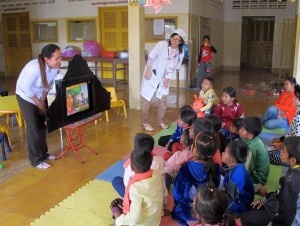Want to innovate paediatric care in Cambodia? Set up a playground in a hospital
2015-07-13

© UNICEF Cambodia/2015/Martina Tomassini
Children draw and colour in the playground at Battambang Provincial Hospital.
By Martina Tomassini, Communication Officer at UNICEF Cambodia
A first-time initiative in Cambodia – “Playgrounds in Hospitals” is helping health care providers, parents and sick children have a better experience during treatment. I spoke with Sedtha Chin, HIV/AIDS Specialist at UNICEF Cambodia, who led this innovative project, to learn more.
Q: In a nutshell, what is the “Playgrounds in Hospitals” project?
Sedtha: The project is about introducing playgrounds into the paediatric ward of Cambodian hospitals to benefit hospitalized children; children with HIV going in for their monthly treatment; hospital staff; and parents. Playgrounds are equipped with toys and books for children and adults to read. The idea is to create an environment where children enjoy themselves and learn while waiting to be treated; healthcare providers are under less pressure because children are not crying to go home; and it’s easier for parents to keep their children waiting.
 © UNICEF Cambodia/2015/Martina Tomassini
Playground facilitator Sngiem Sokha tells a story with kamishibai, a Japanese story-box theatre, in the playground at Battambang Provincial Hospital, Cambodia. |
Q: How did it all start?
Sedtha: In 2007 I worked mostly in hospitals across Cambodia, in their Pediatric Health Care Units. When I travelled the provinces [i.e. rural areas] I thought, “Why don’t we have something like a friendly place for children to enjoy, so that they are less stressed about being in a hospital?”
Often I would see them crying on their beds, looking depressed, just insisting on going home. No child wants to stay at the hospital, right? Then, one day I visited a pre-school and I saw they had a playground. So I thought, “I must try to do something similar in hospitals.”
A few weeks later, when I left the office, I saw a ‘mobile liary’ car painted with children’s images and the SIPAR logo [a French-Cambodian NGO that promotes reading among children and youth]. The following day I got in touch with the organization’s director: I told him about my plan to set up a small |
liary in a hospital. He told me that they have lots of experience setting up mobile liaries with schools [i.e. vans with books and a schedule to visit communities] but they had never set up a traditional liary in a hospital. We were both eager to give it a go so we made a plan.
I went to talk to the director of the National Paediatric Hospital in Phnom Penh, the capital. He was very excited and said, “What a good idea! Why don’t we try it?” He was familiar with the concept of playgrounds in hospitals because he saw during his travels aoad. So we went for it: UNICEF provided the toys and furniture and SIPAR provided the books and trained two playground facilitators who would engage with children in activities such as storytelling and drawing.
The first evaluation based on interviews with parents, health care providers and parents gave us very positive results. The playground was benefiting hospitalized children, particularly in the Severe Malnutrition ward where it was set up, and children with HIV who were not hospitalized but went to the hospital periodically for their medicine. Both doctors and parents had a more pleasant treatment experience. So we decided to scale up to nine hospitals in the provinces, and three years later we’ve added another six hospitals. As of today, there are 17 playgrounds in paediatric wards in Cambodia – and we keep receiving requests for more.
|
Q: Did something happen that you didn’t expect when you implemented this project?
Sedtha: I have seen that in some places, like in Prey Veng and Oudar Meanchey provinces, the hospital where we set up the playground is located near to the local primary school. The community knows that the playground has lots of books and toys to play with. So after school some children go to the playground to read and play. This is something I did not expect when we set this up! I am happy to see that this project is not just benefiting children inside and outside the hospitals, but also the whole community.
Q: What are the plans for the future?
Sedtha: Given the positive feedback, we are planning to continue expanding to ing playgrounds to more paediatric wards in Cambodia. |
 © UNICEF Cambodia/2015/Martina Tomassini
Two boys read one of the many books in the playground at Pailin Provincial Hospital, Cambodia. |
Q: What is the current situation in Cambodia when it comes to children and HIV/AIDS?
Sedtha: Cambodia has been at the forefront of the fight against HIV/AIDS. It is one of the few countries in the world to have successfully reversed its generalized HIV epidemic. The number of children on ART (antiretroviral therapy) has increased steadily, reaching over 80% of children affected by HIV/AIDS in 2014. Today HIV finger-prick testing is accessible at almost all health centers across the country.
Cambodia has done well in terms of providing treatment to children in need ART, however keeping children in ART remains a challenge, especially for children who live in remote areas. We work in close collaboration with the national government and other development partners to support the national HIV/AIDS response and will continue to play an important role to improve services and revise processes so to ensure children and women receive comprehensive services as required.









